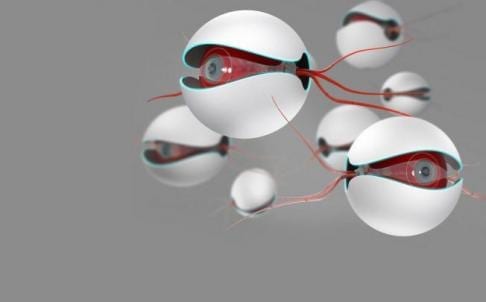
This method could usher in a new approach to delivery of drugs in general
Freiburg researchers find purely chemical way to target therapeutic nano-containers to cells
Scientists have discovered that a polymer can provide a key to get into tumors: Prof. Prasad Shastri, Director of the Institute of Macromolecular Chemistry and core member of the cluster of excellence BIOSS Centre for Biological Signalling Studies at the University of Freiburg, and graduate students Julia Voigt and Jon Christensen have developed a new paradigm to home nanoparticles, containers that measure a few 100 nanometers in size, to endothelial cells. Using just charged polymers with the right affinity for cell lipids the team has developed nanoparticles that can recognize specific cell types simply by their chemical properties. “This is a remarkable discovery, as it allows for the first time to target a specific cell type purely through biophysical principles, and without using the traditional ligand-receptor approach” says Prof. Shastri who led the study that was selected as cover article of the Proceedings of the National Academy of Sciences. Until now researchers placed molecules on nanoparticles that can latch onto proteins on cell surface – called receptors.
These receptors act as an address or a biological postal code. However in tumors these addresses can change rapidly with time. To solve this lack of precision Shastri and team developed particles that are delivered to endothelial cells using a biophysical approach. “This delivery approach does not require a biological postal code for targeting of nanoparticles and is an important step forward in developing nanoparticle based systems for treating cancers” says Julia Voigt the lead author of the paper.
Cancers are very hungry tissues and they need constant nourishment. This is provided through their own supply of blood vessels. “By going after endothelial cells that make up these blood vessels, we can starve the tumor or kill it with one payload” says Jon Christensen who is a co-author on this study and works on tumor metastasis.
Nanoparticles are used to deliver therapeutics in treating cancers. These very small pills, cornerstones of nanomedicine, get injected into the body and reach the tumor cells via the bloodstream. When they find the targeted cells, they need to be eaten so that the drug can act within the cell.
The Latest on: Nanomedicine
[google_news title=”” keyword=”Nanomedicine” num_posts=”10″ blurb_length=”0″ show_thumb=”left”]
via Google News
The Latest on: Nanomedicine
- Human mini-lungs mimic animal response to nanomaterialson April 27, 2024 at 5:05 am
Human mini-lungs grown by University of Manchester scientists can mimic the response of animals when exposed to certain nanomaterials.
- Nanorobotics Market Ethnography Techniques Capturing the Essence of Consumer Behavioron April 25, 2024 at 3:17 pm
Nanorobotics Market is valued approximately USD 5.53 billion in 2019 and is anticipated to grow with a healthy growth rate of more than 10.97 % over the forecast period 2020-2027. Nanorobotics is a ...
- Manchester Scientists Find Novel One-Dimensional Superconductoron April 25, 2024 at 1:31 am
In a significant development in the field of superconductivity, researchers at The University of Manchester have successfully achieved robust superconductivity in high magnetic fields using a newly ...
- Vietnam Nanorobotics Market Ethnography Techniques Unlocking Consumer Emotions and Behaviorson April 24, 2024 at 4:26 pm
Report Ocean’s latest analysis delves into the “Vietnam Nanorobotics Market” Report from 2024 to 2032, covering an array of market facets such as characteristics, size, growth, segmentation, regional ...
- MIT Technology Reviewon April 23, 2024 at 2:00 pm
MIT athletics” when their daughter Lauren ’17 captained the women’s soccer team. So they made a gift that will name the weight room in MIT’s updated Sports Performance Center and funded a matching ...
- Novel Drug Made of Gold Nanocrystals Appears Safe in Multiple Sclerosison April 22, 2024 at 10:22 am
DENVER -- An oral suspension of clean-surfaced gold nanocrystals known as CNM-Au8 was safe and well-tolerated in patients with stable relapsing-remitting multiple sclerosis (MS) and chronic optic ...
- Nanoparticles Deliver Drugs Directly Across the Blood-Brain Barrieron April 22, 2024 at 9:02 am
It was conducted on behalf of Clene Nanomedicine, Inc., or Clene, a clinical-stage biopharmaceutical company. Mahmoudi said, “Because we have more than 15 years of evolving experience with robust ...
- Researchers set new standards for nanoparticles, helping patients with MS, ALS, Parkinson's diseaseon April 19, 2024 at 9:31 am
Is it possible for nanoparticles to go through the digestive system and deliver medicine directly to the brain tissue? Researchers from Michigan State University say yes, and their latest findings are ...
- Scientists grow human mini-lungs as animal alternative for nanomaterial safety testingon April 18, 2024 at 8:35 am
Human mini-lungs grown by University of Manchester scientists can mimic the response of animals when exposed to certain nanomaterials. The study is published in Nano Today.
- Fifteen students receive SUNY Chancellor’s Awardon April 18, 2024 at 5:17 am
Fifteen UB students have been named recipients of the SUNY Chancellor’s Award for Student Excellence, the highest honor SUNY bestows upon its students. The award, created in 1997, is given annually to ...
via Bing News











